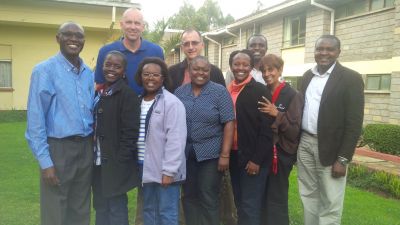In 2012, as part of their work together in disaster preparedness, Integral Members in Kenya came together to work on a peace campaign in the run up to national elections. The Integral Programme Group developed a Shared Country Approach Strategy in late 2013 with plans to pilot this approach in 5 countries. As part of this strategy the Kenya group have adopted a broader remit looking for opportunities to collaborate at country level in both their relief and development work in 2014. Here we find out more from Mbaraka Fazal, Tearfund UK’s Disaster Management Adviser in Kenya and the group Chair, about their future plans to collaborate for greater impact…

Back row – Rt to Left -Harun Muthama – World Concern, Norman Holbrook – World Relief Canada, Stephan Lutz – World Renew
Are there any benefits being seen today from the peace work that you did in 2013?Within the communities where we did the peace campaign, it is difficult to say that the peace that was upheld was due to our work. What we can say is that peace was upheld and that was the choice of the communities. As Integral Alliance Members, it brought us closer and more committed to working together.
Why did the Kenya country group reconvene in 2014 and what happened as a result?
We reconvened to discuss what we wanted to do together, why we wanted to be together and where we wanted to go, and also whether it made sense to explore working jointly. The group felt there were opportunities and there was a willingness to explore what those might be. This led to us to taking 2 days out of our schedules to work on a strategy.
Can you describe something of the process whereby you reached agreements about future action?We got a consultant to take us through the process and they asked us what our motivations, benefits and risk of coming together were. We did an analysis of our strengths, weaknesses, opportunities and threats and the changing context within which we work. This gave us a perspective of what our comparative advantage would be in working together. This then led us to asking how we would do it.
What was decided, and why?
In order for us to be a Country group, we needed an MoU to govern and manage our membership, engagement and commitment. So at present, we have a group developing the MoU. We thought of a process that would guide our engagement in planning and preparedness, decision making and response or action together during a disasters. This includes learning, opportunities to act together and being proactive. This will then translate into practical actions. As to the why: our identity – ‘Christ Centered togetherness in transformation’ which would enable us to work effectively in disasters, relief and development.
What has been some of the work highlights for you in coming together with other Integral Members in Kenya?
The amazing people on this group! There has been so much goodwill and commitment. Also working jointly on the peace campaign, the synergy and gifting of the different Members and now the strategy.
What do you see as the added value of collaboration in your context?
I would highlight four areas where I see potential added value:
– The large coverage within the different geographical areas and the unique strengths and specialties of each Member organisation can actually add a lot of value to each other’s work.
– The wealth of experience and learning from one another.
– The difference we could make for the communities and our sphere of influence with the church is a great opportunity.
– The opportunities to bid for joint funding as a consortium.
What would you say the main challenge is?
Time – to ensure there is enough time to move things forward, and for each one of us to set apart time to do the things we do.
What do you hope to achieve as a group in the future?
Two major things: One – work on the Lapsset* project to ensure communities are prepared to engage with developmental opportunities and therefore mitigate potential conflict. Second – to have Member Agencies that are well positioned to respond to disasters and take advantage of any development opportunities.
Has there been a particular personal blessing/benefit for you in being involved in the Integral country?
It’s been a blessing to engage with so many different people at different levels in and out of the country and seeing their commitment and passion to working together. It is very inspiring.
* LAPSSET stands for Lamu Port Southern Sudan-Ethiopia Transport and is a transport and infrastructure project in Kenya that, when complete, will be the country’s second transport corridor.



